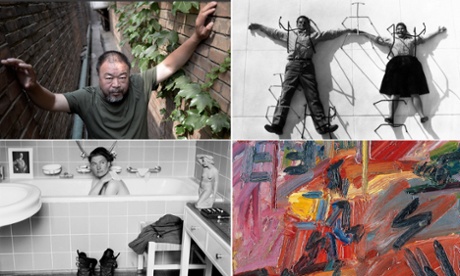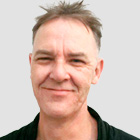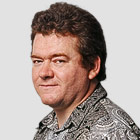Palladian Design: The Good, the Bad and the Unexpected
From the stately dome of the US Capitol in Washington DC to the rugged concrete columns of a recently built cowshed in Somerset, the influence of Renaissance architect Andrea Palladio persists across centuries and continents, his lasting legacy often found in the most unlikely places. Organised by the Royal Institute of British Architects, which owns the vast majority of Palladio’s surviving drawings, this exhibition will shine a spotlight on how Palladian style began and proliferated, bringing together a fascinating range of models and pattern books that influenced the design of buildings from New Delhi to St Petersburg. Oliver Wainwright
- RIBA, London, 9 September–9 January
Bridget Riley: Learning from Seurat
Two great artists bounce and fizz off each other in an exhibition that compares Bridget Riley’s early masterpieces of abstract art with the 19th-century painter who helped inspire them: Georges Seurat. Too often Seurat is summed up in a word – “pointillism” or the use of little dots – or even just seen as a slightly pixelated impressionist. In fact, his fractured, pulsing, eerily still fields of light and colour teeter on the edge of abstraction and anticipate 20th-century science as well as art. Perhaps what he and Riley have in common is that scientific sensibility; that interest in how the eye works and how we mix the colours of reality in our minds. This promises to be another in this little gallery’s run of outstanding shows. Jonathan Jones
- Courtauld Gallery, London, 17 September–17 January
The World Goes Pop
Groundbreaking attempt to place pop art in its global context or another rehash of familiar names and images? The World Goes Pop examines not so much a movement as a variety of responses to culture under capitalism and consumer culture. With artists from Brazil to the former Yugoslavia, Japan to Colombia, and an emphasis on women, The World Goes Pop focuses on figures often written out of the story: the overlooked, the ignored and the marginal. Everything is pop, even when it isn’t. Adrian Searle
- Tate Modern, London, 17 September–24 January
Zanele Muholi: Vukani/Rise
Following her shortlisting for this year’s Deutsche Börse photography prize, South African photographer and visual activist Zanele Muholi receives her first major UK exhibition. Three recent series trace Muholi’s continuing engagement with gender, race and politics in her native country, alongside her most well-known project, Faces and Phases (2006–2015). The latter comprises over 200 portraits of black lesbians and transgender men alongside often visceral video and audio testimonies of the hate crimes and violence, including so-called corrective rapes, directed against them. An invaluable archive of a defiant community that is complemented by a smaller series, Brave Beauties (2013–2014), in which the body is celebrated in a more flamboyant, but always tender, style. Sean O’Hagan
- Open Eye, Liverpool, 18 September–29 November
Ai Weiwei
Straddling the poetic and the political, Ai Weiwei’s work is trouble. Sculptor, conceptualist, architect, blogger, top-level blackjack player and critic of corruption and social injustice, Ai is the most famous and outspoken artist to emerge from post-revolutionary China. This has led him into serious difficulties in his homeland, including a period of detention, the removal of his passport and the demolition of his Shanghai studio by the authorities. For all that, as an artist Ai is a maker of beautiful, sorrowful and acerbic things. This long-overdue survey should allow us to focus more on the art, less on the man. AS
- Royal Academy of Arts, London, 19 September–13 December
Celts
This is a very timely look at the very fabric of British identity – not to mention the brooches, illuminated gospels and swirly designs on shields and Celtic crosses. Many of us call ourselves Celts. In political history, the “Celtic fringe” was once taken for granted. Now that the British nation state suddenly looks so much less stable and enduring, the reality of the Celtic stream in our history deserves a fresh look. This exhibition sets out to show that “Celt” is a cultural construct, not an ethnicity. The word has been used with different meanings, and is as much a modern myth as a historical reality. We may not be who we think we are, after all. But just get a load of those whorls and whirls and cool helmets. JJ
- British Museum, London, 24 September–31 January
Mat Collishaw
Sex and death – what else is there to make art about? Oh yes, drugs. Other Young British Artists who came to prominence in the 1990s have since either “grown up” or tried to and failed (stay out of the painting shed, Damien), but Mat Collishaw has remained true to what might be called the ideals of that provocative generation. He still tackles shocking subjects, from last meals on death row to City cocaine-taking, with a brazen bravado. His photographs, films and objects dwell on the morbid and the sleazy with a dedication worthy of Baudelaire. This artist is bad for you. JJ
- New Art Gallery, Walsall. 25 September–10 January
Emily Jacir: Europa
Palestinian artist and film-maker Emily Jacir focuses on migrations and returns, losses and restitution. The first UK survey of her films, photographs and installations has at its heart her Material for a Film (2004), an immersive installation focusing on the assassination of Palestinian writer Wael Zuaiter by Mossad agents in 1972, and her search for the writer through the traces he left. Other works pursue journeys begun and diverted, projects abandoned, troubled histories unpicked with great poignancy and an affecting lightness of touch. AS
- Whitechapel Gallery, London, 30 September–3 January
Diffusion: Cardiff international festival of photography
Following 2013’s inaugural edition, the second Diffusion festival is subtitled Looking for America. Among the highlights are a group show, And Now It’s Dark, which looks at the night photography of contemporary American photographers like Todd Hido, Jeff Brouws and Will Steacy. Kentuckian Stacy Kranitz presents As It Was Given to Me, which contrasts the lives of a beleaguered mining community in south Wales with their counterparts in rural Appalachia, while Clémentine Schneidermann unveils her intriguingly titled series, I Called Her Lisa Marie, focusing on Elvis obsessives in Memphis and Porthcawl. SOH
- Various venues, Cardiff, 1-31 October
Turner prize
After a couple of disappointing years, the prize heads to Glasgow, the city that has provided more winners than any other. None of the artists on the current shortlist have a Glasgow connection. For my money, Assemble, a collective of London-based artists-cum-designers and architects, are the frontrunners in a shortlist that includes Janice Kerbel, Bonnie Camplin and Nicole Wermers. AS
- Tramway, Glasgow, 1 October–17 January’
Burden of Proof: The Construction of Visual Evidence
A thought-provoking look at how photographs have been used as evidence in crime investigations and war crimes tribunals and as state records of those sentenced to death during political purges. Ranging from the earliest use of photography to assist police investigations in the late 19th century, to images of drone strikes in Pakistan in 2012 and the indiscriminate destruction of Gaza in 2009, the exhibition highlights the often-contested nature of photographic evidence. SOH
- The Photographers’ Gallery, London, 2 October–10 January
Alec Soth: Gathered Leaves
The first major UK show for perhaps the most influential contemporary American documentary photographer will comprise a survey of his work over the last 10 years. It begins with his breakthrough series, Sleeping By the Mississippi (2004) and culminates with his most recent project, Songbook (2012–2014), which looks at the often old-fashioned ways that people connect with each other in the age of social media. SOH
- Media Space, Science Museum, London, 6 October–28 March
Goya: The Portraits
Realist, caricaturist, critic and lover, Goya’s confrontations with royalty, politicians, doctors, lovers, children and, most tellingly, himself are filled with cruelty and empathy, humour and affection. He is unsurpassable, and the flaws in his art make it even more wrenching. Goya’s portraiture deserves a show bigger than even the National Gallery can provide, in what is claimed to be the first exhibition to focus entirely on this side of his work. AS
- National Gallery, London, 7 October–10 January
Newport Street Gallery, Caruso St John
Ageing YBA prankster and master of shock art Damien Hirst has now put his curatorial hat on, opening a £25m new gallery of his own – which he promises won’t be filled with his own work. Tucked down the side of some railway arches near Vauxhall, the Newport Street Gallery is to be a showcase for some of Hirst’s 3,000-strong collection, which ranges from Francis Bacon to Banksy and Jeff Koons. Designed by Caruso St John, go-to architects of the art world, who recently worked their magic on remodelling Tate Britain, the 37,000 sq ft gallery takes over three former Victorian scenery-painting studios, bookended by two new buildings threaded with spiral staircases, silky ceramic handrails and topped with sawtooth northlights. OW
- Newport Street Gallery, London, opens 8 October (see below)
John Hoyland
This British abstract painter’s work is the opening show and consists of paintings from Hirst’s own collection. Why does he love Hoyland? Is he right to? Is Hirst now trying to become Britain’s most influential art collector and redefine taste? Hoyland is not exactly one of Hirst’s own generation, so this suggests a wide-ranging approach by Hirst the collectorWho knows: perhaps he will have the kind of impact as a collector and gallerist that a certain Charles Saatchi once had? JJ
- Newport Street Gallery, London, 8 October–3 April
British Art Show 8
The collaborative restoration of an old Mini by former workers of the Longbridge plant in Birmingham, a new film by John Akomfrah and Trevor Mathison, and an ant farm are among the works by 45 artists in this five-yearly look at the state of British art. Pick holes in the list of artists if you will, but any show including Akomfrah, Simon Fujiwara, Rachel Maclean, Charlotte Prodger, Laure Prouvost, Hayley Tompkins and Bedwyr Williams has something going for it. The last British Art Show was the best so far. My breath is bated, pencil sharpened. AS
- Leeds Art Gallery, 9 October–10 January. Then touring to Edinburgh, Norwich and Southampton
Frank Auerbach
There are many artists who are flashy, sensational and entertaining. There are not many who dig down into the substance of life as tenaciously as Frank Auerbach. The sheer lust for life that ruts and ripens Auerbach’s paintings is as powerful as London itself, the city whose streets and parks provide his only subject, along with intense portraits of friends. His style cannot be emulated because it is not a style. The massive textures and trench-like clay colours of Auerbach’s grasping, searching works are not mannered effects, but the visible process of a painter wrestling with what he sees and feels. Authenticity is in fashion, they tell me. Here is an authentic modern master. JJ
- Tate Britain, London, 9 October–13 March
Bill Viola
A chapel that stands among the rolling landscapes of Yorkshire Sculpture Park provides a perfect setting for part of this retrospective of the pioneering video artist. Viola is daring and unusual among contemporary artists in the forthright way he engages with religion. The spiritual art of the past echoes in his work – martyrs, triptychs, meditation, all that sacred jazz. But it is not (necessarily) an art of belief. Rather, this Californian artist is fascinated by the loneliness and insight of the saint and the mystic, by the varieties of religious experience. Out of this real emotional quest he has arguably created the most serious and worthwhile work ever done in the name of video art. JJ
- Yorkshire Sculpture Park, Wakefield, 10 October–10 April
Cy Twombly
The greatest painter since Jackson Pollock was a paradoxical genius who ranged from the gutter to the gods. His art is at once earthy and sexy, and fraught with the burdens of history. Twombly is simultaneously an abstract artist and a poetic storyteller. Dealer extraordinaire Larry Gagosian has picked the most marvellous artist on his books for the first exhibition at his new gallery in Mayfair, London. It includes previously unseen paintings from Twombly’s Bacchus series, in which he finds a sensual, graffiti-like analogy for the irrational power and frenzy associated with the ancient Greek god of wine. What an artist. JJ
- Gagosian Gallery, London, 10 October–12 December
Fiona Banner: Scroll Down and Keep Scrolling
Described by the artist as an “anti-survey”, this look back at over 25 years of art-making should be a rumbustious affair. War movies and fonts, fighter planes and life models have provided the materials for written drawings and sculpted full stops, balletic wind-socks, and furious and gigantic novels. The thwapping beats of Chinook helicopter blades accompany a tower of glass and warzone photographs of London’s financial district. Banner is a tough and confrontational artist. Boys and their toys had better watch out. AS
- Ikon Gallery, Birmingham, 10 October–17 January
Abraham Cruzvillegas: Empty Lot
Tate Modern’s Turbine Hall commissions are always sprung upon us. One year sunflower seeds, another year slides or sunsets. Now with a new sponsor, Hyundai, the annual series recommences with Mexican artist Abraham Cruzvillegas’s Empty Lot. Working with the near-to-hand, and an acknowledgement of the necessary, improvisational way in which rural Mexicans build houses – and lives – for themselves in the city, Cruzvillegas’s art is both sculptural and conceptual, founded in both materiality and necessity. This attitude of autoconstrucción (self-construction) is also at the heart of Cruzvillegas’s art. Go on, surprise me. AS
- Tate Modern, London, 13 October–3 April
Frieze and Frieze Masters
The dynamism, unexpectedness and sheer abundance of the art market makes these art fairs a window on the new – and the old. From the latest sensation to the oldest masterpiece, there will be plenty to entertain, irritate and make you drop your jaw in amazement. London’s galleries are diverse as well as energetic. Look out for real experts in their fields among the dealers, like modern print connoisseur Alan Cristea and bronze-sculpture authority Daniel Katz. But the whole international art world, and not just London, is on view at Frieze. Even if you find a lot of it plutocratic nonsense, you will see something stupendous, or delicate, or mind-expanding. It’s friezonomics. JJ
- Regent’s Park, London, 14-18 October
Lee Miller: A Woman’s War
Yet another Lee Miller exhibition, but this one looks at the impact of the second world war on women’s lives though her portraits and photojournalism. According to the IWM’s press release, this is the first exhibition to “address Miller’s vision of gender” – if, of course, she ever consciously had “a vision of gender”. Either way, we are promised many images, objects and personal items never exhibited before. A treat, then, for fans of one of the great photojournalists. SOH
- Imperial War Museum, London, 15 October–24 April
The World of Charles and Ray Eames
“Take your pleasure seriously” was the advice given to any new recruit to the office of Charles and Ray Eames, the American duo who defined an era of postwar optimism and experimentation in design. The pleasure they took in their own work, which ranged far beyond their famous fibreglass and bentwood furniture, to film-making, animation and exhibition design, will be palpable in this extensive exhibition, whose curators have delved deep into the 1m-strong collection of the Eames Office archive to paint a comprehensive picture of their unparalleled output. OW
- Barbican, London, 21 October–14 February
Faith After the Pharaohs
Egypt is the home to a diverse religious history has generated extraordinary art. Coptic Christianity has its own unique style, with touching, almost naive portraits and manuscripts, ancient monasteries and churches. This minority tradition has coexisted with the majority religion, Islam, whose own architectural and artistic splendour shapes the best-preserved quarters of Egyptian cities. Yet there is also a rich Jewish history in the country, and this, too, is explored. Not only does it show that Egypt has carried on being a great cultural centre long after the age of thepyramids: it also reminds us of the complexity and pluralism of life, art and history in the Middle East. JJ
- British Museum, London, 29 October–7 February
Theaster Gates: Sanctum
For 24 days, the medieval ruins of Bristol’s Temple Church, bombed in 1940, are going to come alive with the voices and sounds, beats and songs of the city. Theaster Gates’ first public project in the UK follows his extraordinary interventions in his Chicago hometown and in a destroyed Huguenot house in Kassel. Gates wants the church ruins to resonate with sound, round the clock, for 576 hours. Gates’ public projects are sites for protest and celebration, and have a therapeutic, spiritual core. Above all, they’ve got soul. An unmissable treat. AS
- Temple Church, Bristol, 29 October–21 November
Alexander Calder: Performing Sculpture
Why should sculpture be still and why should it stand on the floor or a plinth? Like a tinkering artistic version of Edison or the Wright brothers, this great American sculptor asked basic, brave questions and found inventive answers to them. Calder’s most famous invention is the mobile – a loose constellation of coloured shapes suspended by wire or thread and gently moving in free space. Calder’s mobiles resemble three-dimensional animations of his friend Joan Miró’s surrealist paintings, but they also, surely, mirror the subatomic worlds that were being discovered by quantum physics in the 1920s and 1930s. He also created, among other delights, a mercury fountain and fantastical furniture. Calder is the engineer of human dreams. JJ
- Tate Modern, London, 11 November–3 April
Enrico David
It was only with his staged assembly of improbable, flopping, rearing figures in the 2009 Turner prize that I began to get Italian-born sculptor and installationist Enrico David. He has moved on, but there is still an element of the farcical in his subsequent paintings and sculptures. Ribald and scatological, mournful and jesting, David’s work grows richer with time. A game of sculptural manners, materials and scale, and working between abstraction and figuration, David’s development is filled with surprises, rather than just more of the same. AS
- The Hepworth, Wakefield, 13 November–24 January
Cycle Revolution
As the two-wheeled revolution continues apace, cyclists take over the Design Museum this autumn, with a show that takes an in-depth look at bicycle culture through the lens of four “tribes” – from the Lycra-clad High Performers in pursuit of Olympic speeds, to the mountain-biking Thrill Seekers, to the fixie-bestraddling Urban Riders, to the Cargo Bikers earning a living on two wheels. The show will include a bike-making workshop, demonstrating how bespoke frames are made, as well as a section looking at the future of cycling and how it is affecting the infrastructure of the city. OW
- Design Museum, London, 18 November–30 June














